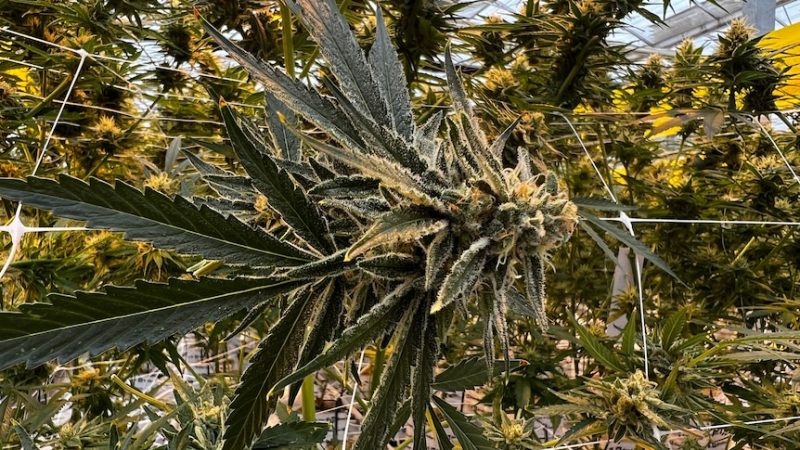Why cannabis enthusiasts are divided over legislation to legalise recreational marijuana in Australia

By his own admission, Tom Varga gets high on his own supply.
The co-founder of one of Australia’s biggest medicinal cannabis farms oversees the production of 5,000 kilograms of the plant annually inside a soccer-field-sized greenhouse in regional Victoria.
“Most of the guys that work here, including myself, have scripts and are cannabis users,” Tom told ABC News.
“It’s a great plant-based alternative for stress, anxiety and, absolutely, for adult use when [people are] hanging out with mates.”
After the legalisation of medicinal cannabis in 2016, Tom believes it is “inevitable” that recreational use will soon be decriminalised nationally and converted into a multi-billion-dollar legal industry.
“There is a place for us to think about how adult use evolves into the market. We have a massive adult use market here that’s illegal at the moment,” he says.
Yet despite this, Tom does not support the first bill lodged in federal parliament to create a legal recreational cannabis market.
The reason why speaks to infighting that’s been bubbling away in the world of weed. It is dividing users who are usually united by their love of cannabis, and leading to debate about the corporatisation of a plant.
What is this federal bill to legalise weed?
In most jurisdictions, it is still illegal to use, possess, grow and sell cannabis, except in the ACT where it has been decriminalised and is now legal to grow at home for personal use.
Currently on the black market in Australia, an ounce (or 28 grams) costs around $280 to $300, a drug dealer who spoke to ABC News on condition of anonymity confirmed. This works out to around $10.70 a gram.
Buy less and you get the dried buds for around $14.20 a gram. A typical joint usually has about a third of a gram in it.
The margin on sales is about 50 per cent, the dealer added.
“There’s a shitload of money in it,” he said.
Campaigning on a policy to cut out drug dealers, Australia’s third-largest political party, the Greens, lodged a bill to legalise the drug this year.
The politician leading the effort is David Shoebridge, who happily admits to having tried Australia’s most popular illicit drug before he was elected to the Senate.
“I’m a Greens senator. Of course, at some point in my life, I’ve consumed cannabis,” he jokes.
He believes legalisation “just makes so much sense”.
He says costings done for the Greens by the independent Parliamentary Budget Office (PBO) show a legal industry could generate $28 billion in government revenue over the course of a decade.
That would come from GST, company tax and a 15 per cent specialist sales tax.
“Take all of that economic activity out of the hands of organised crime and put it into legitimate businesses, get some public revenue, and put on checks and balances,” Senator Shoebridge argues.
He adds there would be savings from not having to enforce criminal punishment for users and dealers. Currently, states and territories take the wheel on this.
Senator Shoebridge says it is likely that some people who use cannabis recreationally are now getting it through medicinal marijuana scripts, and this shows “the existing medicinal market is already bleeding into the recreational market”.
“We think that there’s an unstoppable national momentum towards legalising cannabis. It’s a matter of when, not if, in our mind,” he says.
So what does legalisation look like?
Senator Shoebridge doesn’t just want Australians to smoke cannabis.
The Greens model includes “dispensaries” and cannabis co-operatives selling all sorts of products, including “edibles”, which is where the cannabinoid component that gets people high is put into food.
“Maybe a cannabis matcha latte on a Friday afternoon,” Senator Shoebridge suggests.
“Or a brownie. Or a cannabis gummy or drink.
“We didn’t want to be the fun police.”
However, the model does put strict rules onto advertising the drug, an age limit of 18 to match alcohol, driving, cigarettes and voting, and exemptions on “big pharma, big tobacco and big alcohol”.
Instead, Senator Shoebridge says they would like a model where the many producers and sellers are small-to-medium-sized businesses around Australia.
“We wanted to have a system which basically democratises the market,” Senator Shoebridge says.
“So if you’re a small cooperative on the north coast of New South Wales, you can get a licence, start cultivating, and sell it into a co-operative and sell it into a dispensary.
“And actually see some of that money not get soaked up into big corporates, but actually get delivered straight back into communities.”
It is this part of the idea that Tom Varga’s Green Farmers is worried about.
His company has already poured millions into creating a facility that adheres to the high standards of selling medicinal marijuana under Therapeutic Good Administration (TGA) approvals, with Tom adding it is “very difficult to get a license”.
All of the company’s 40 workers inside the greenhouse are decked out in sterile clothes.
The tens of thousands of seedlings they cultivate and then grow into 2-metre-tall plants are grown near-organically with bugs to control disease. This ensures a consistent, clean product, Tom says.
“[Our customers] know what they’re getting every time, labelled on the jar,” he adds.
“Whether it’s cows, capsicums, or cannabis: with what we ingest and inhale, we have an expectation for patients and for consumers that it meets minimum standards.”
The company owner fears the Greens model would flush the market with substandard chop made by under-regulated small-time producers. The Greens dispute this and say their model would still regulate quality.
Legal recreational marijuana could also hurt medicinal marijuana sales if it is sold too cheaply into the market.
The PBO modelling for the Greens suggests adult-use cannabis would be made for just $1.10 a gram and sold for around $13.
Any lower, and that would get far cheaper than the current prices of medical cannabis, which is not subsidised by the Pharmaceutical Benefits Scheme (PBS) in Australia.
“The issue with the Greens is, they’re looking for headlines,” Tom Varga says.
“You need [companies] that can produce large volumes of cannabis at scale at a competitive price, like what we can. You’re also going to need the guy that can make a really unique boutique cannabis. So you need both of those in the market.
“At the moment, the Greens policy maybe neglects some of that.
“[Their policy] is destined for failure.”
As you’d expect, the drug dealer who spoke to ABC News was not supportive of legalisation.
He said this was “not just out of personal interest” but because they believed legalisation would drive proceeds to rich people.
“It will result in an upward class distribution of the proceeds. This will go to corporate profits and petit bourgeois rich kids.”
They said they had already lost “a little bit of business” to medicinal marijuana, but that people with legal scripts still often buy off them because legal TGA-authorised weed is more expensive than illicit market cannabis.
What do other weed enthusiasts say about legalisation?
Debate between weed enthusiasts is playing out in other jurisdictions.
In Victoria, the Legalise Cannabis Party — which has two people elected to the state’s parliament — is also pushing for widespread reform through a “three-step” plan.
“We always joke that our name is on the tin,” LCP member of parliament Rachel Payne tells ABC News.
“The majority of people who continue to use cannabis, use it socially. They use it instead of having a glass of wine.
“I know myself I would prefer to be able to enjoy a joint on a Friday night with friends in my home.
“I’m a medicinal cannabis patient. I use it for endometriosis and period pain. I also use cannabis to relax and for anxiety.”
Ms Payne is worried that many people who need it for medicinal purposes can not afford it at the industry’s prices.
“A friend of mine with Parkinsons’, his prescription for medicinal is over $1,000 a month,” she says
“He can’t work. So obviously he has to subsidise his cannabis with illicit cannabis.”
The MP recently lodged a bill in Victoria to decriminalise the drug and let people grow the plant for personal use — as in the ACT — as well as gift it to each other without punishment.
However, she says the party is still “developing” its final policy on full commercialisation.
Their ideas include initiatives like social clubs where people can grow and consume together, such as in Spain and Malta.
“What this looks like for us is maintaining a grassroots approach,” Ms Payne explains.
“Some of the models around commercialisation you could argue haven’t really had health front and centre. It’s been more about the business sense of where the industry is going.
“For us, it’s about harm minimisation and a health-led approach.”
Commercialisation could come down to the federal government
A recent High Court decision that ruled Victoria could not enforce a controversial tax on electric car owners has put a spanner in the works for commercial cannabis.
Ms Payne says the advice given to their party is that it may become difficult to create a taxed cannabis industry in the state without the support of the Commonwealth.
Jenny Williams, who is an economist at the University of Melbourne who studies cannabis, backed this assertion.
“It’s incredibly complex,” Dr Williams says.
“It will take for the federal government to make footsteps on a federal tax.”
This means the Greens bill is the one to watch when it comes to full commercialisation of legal weed.
Its bill will be debated in parliament next year and needs support from at least one of the other major parties to pass.
The ruling federal Labor Party would not be interviewed or disclose its position on the legalisation of adult-use cannabis in Australia.
However, a spokesperson said legalising cannabis was a matter for the states and territories.
With Labor indicating it does not support the bill at this stage, this leaves the support of the Coalition, which was actually the party that paved the way for legalised medical marijuana back in 2016.
Coalition member and shadow attorney-general Michaelia Cash told ABC News she “fundamentally disagrees” with going further.
“I have spoken to many parents over many years in relation to their children who have utilised drugs and even cannabis. And those who’ve had detrimental effects,” she says.
Unlike other politicians interviewed for this story, Senator Cash says she will not be partaking in the drug if it is ever legalised.
“If I go into a coffee shop, quite frankly, I’m happy to have a normal cup of coffee.”
The Australian Medical Association (AMA) has also come out against the Greens bill.
“The AMA is concerned that if cannabis were legalised for recreational purposes, it may increase health and social-related harms,” their statement says.
“This in turn may increase demand on an already overstretched healthcare system.”
Other submissions by anti-narcotics groups to the Greens bill, which were just published online, also argue that cannabis use is linked to psychosis, lung cancer and domestic violence.
“Australia is running a general experiment in exploitation,” a submission from Drug Free Australia said, adding that medical cannabis was already “spreading degradation”.
“The harms outweigh the benefits,” the Drug Advisory Council of Australia added.
What about the economic benefits?
As well as being worried about the health consequences, Senator Cash also disputes the economic benefits of a commercial weed industry.
“This is ideology masquerading as economic policy. Is this the best the Australian Greens have to offer?” she asks.
“The economic analysis is highly uncertain. They haven’t even done the basic groundwork.”
Dr Williams agrees the PBO modelling done for the Greens is “not right”.
She says it assumes that 12 per cent of the population is currently consuming “on a regular basis” of around 6 grams of cannabis per week.
“So basically, they are using every day,” Dr Williams says.
The economist — who models market predictions across health data — says current statistics indicate that just 1.68 per cent of Australians over 14 years old are using it every day.
This could mean the Greens’ economic benefits are either wildly overstated or predicated on a massive surge in uptake.
“The PBO modelling has accounted for the reported distribution across the population and significant variation between the volumes consumed by low frequency users and daily users,” responds a spokesperson for Senator Shoebridge.
“To provide some context for the uncertainty in costings, the PBO note that for every one gram change in the assumed grams consumed per week there is a 15 to 20 per cent change in the annual financial impact of the proposal.”
However, Dr Williams says there is still a lot of evidence that legalisation would have economic and social benefits.
“The most recent estimates of enforcing Australia’s current cannabis laws is that it costs more than about $1.7 billion a year,” Dr Williams says.
“And two-thirds of those costs — so $1.1 billion annually — is from imprisoning people for simple cannabis offences.
“There’s a lot of evidence that putting people in prison or criminalising cannabis use doesn’t reduce their use.
“It makes things more difficult for them. It makes it more difficult to get a job or to get housing.”
She acknowledges the debate emerging about whether a commercial market should be tightly controlled or a free market.
She says if the legal weed is not sold cheaply enough, then people will continue to buy it off drug dealers, but that too low a price would encourage a surge in uptake in Australia.
“The point of legalisation is to shift demand into the legal sector,” she says.
“Cannabis use by young people occurs under criminalisation. Legalisation provides an opportunity to destigmatise cannabis and to really address [use] using a medical model.”
One of Australia’s most-recognised authorities on drug and alcohol reform is also now in support of legalisation.
The Penington Institute’s opinion is that “community views on cannabis have fundamentally changed” and “the best way forward is a strictly regulated legal market that prioritises safety and health”.
Its chief executive, John Ryan, tells ABC News the institute is still coming up with its preferred model.
“A free-for-all approach or a very lightly regulated approach is not a healthy way forward. We’ve seen that, for example, in Thailand, and I think we’ve seen that in Colorado,” he says.
“That means too much advertising, too much marketing, we shouldn’t repeat the mistakes that we’ve made with alcohol and tobacco.”
Will Australia ever legalise weed?
With dispute ongoing between weed lovers and the Greens bill unlikely to pass next year, it is unclear when or even if Australia will ever embrace a legal recreational cannabis industry.
The federal government’s latest National Drug Strategy Household Survey shows more people than ever support legalisation. At 41 per cent in favour, that number is higher than those against.
While he is not a fan of the Greens’ policy, Green Farmers co-founder Tom Varga says he supports the national debate their bill has created in Australia.
“The infighting you’re seeing at the moment is a little bit too much ego and not enough thinking of the end user,” he says.
“There’s a real challenge if you think about the legacy guys who’ve been the custodians of this plant the last 70 years during prohibition, versus now, we’re in a legal landscape and what some of the corporate guys want.
“There is a balance between what those two worlds need.”
He personally believes that legalisation will come sooner than many may suggest.
“I’d be disappointed if it isn’t within 10 years, but I think it’s unrealistic to think it’s three years,” he says.
“I really hope we’re mature enough as a country and as a political environment to make sure we have this happen sooner.”
Senator Shoebridge, meanwhile, says it is “bizarre” that their bill had not found support from some medicinal cannabis companies.
“They may not have noticed, but there is a multi, multi-billion-dollar illegal market at the moment, with no labelling, no regulation,” he says.
He also believes legalisation is inevitable and said that, if the federal government did throw their weight behind the Greens bill, he would happily invite the prime minister down to a cannabis cafe to indulge.
“When we get this sorted out, I’ll invite him down to one in [Canberra] and maybe he can chill out after a pretty intense parliamentary week,” he says.








